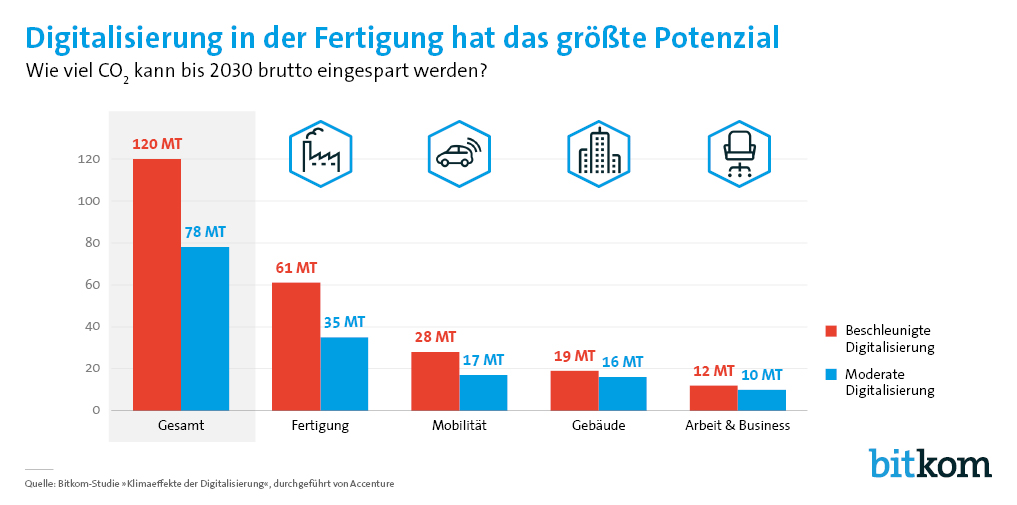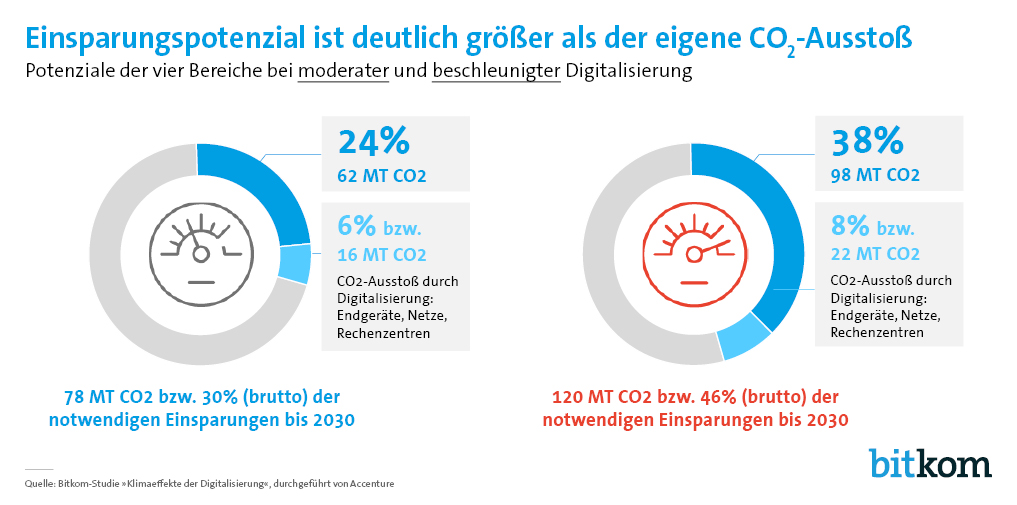How digitization saves climate change
A study by Bitkom shows that almost half of the climate targets can be achieved by 2030 through digitisation. The study was carried out by Accenture. Particularly noteworthy is the figure of 120 megatonnes. This corresponds to the amount that could be reduced. The industrial and mobility sectors in particular are very lucrative. Furthermore, the CO2 footprint is being examined in more detail.
In principle, Germany has set itself the target of producing 543 megatonnes of CO2 in 2030, which is slightly more than half (55%) of the 1990 level. For comparison: in 2019, emissions were 805 metatonnes of CO2.
In order to achieve this target, all sectors must become active. The Bitkom study “Climate Effects of Digitization” therefore examines the potential of digitization in relation to these goals. In this context, seven areas are examined more closely.
Moderate and Accelerated Digitization
In order to make the results as tangible as possible, two scenarios have been examined more closely: moderate and accelerated digitization.
In the first case, the current speed is maintained. In addition to the framework conditions, this includes current incentives. Digitization is understood to be accelerated if new incentives are introduced to increase the pace.

How could things continue?
The study shows that digitization could save up to 78 megatonnes of CO2 at a moderate speed. This corresponds to about 30 percent of the targets. By 2030, 120 megatonnes could be saved through new incentives and thus a higher speed. This corresponds to 46 percent.
The Results in Detail
Industrial production
As the graph also shows, industrial production has the greatest potential. A total of 35 megatonnes or 61 megatonnes, through accelerated digitization, could be saved . Particularly noteworthy here are automation in production and the digital twin. The former represents a process in which plants, machines, workpieces and components are networked with each other and work autonomously with the lowest possible energy input. The digital twin enables material, energy and resources to be saved by testing the individual processes on a digital product.
Mobility
Mobility is in second place with 17 and 28 megatonnes respectively, and in addition to intelligent traffic control and smart logistics, it also emphasises sharing mobility. To explain: intelligent traffic control is understood to mean, for example, GPS systems in cars that generate data, which causes traffic lights to be switched accordingly or traffic flows to be diverted. Smart logistics reduces empty runs and optimises freight routes. If several drivers share a vehicle, one speaks of car- or ride-sharing. Depending on whether the users have a similar destination or not.
Buildings
Smart homes and networked buildings enable savings of 16 and 19 megatonnes of CO2 respectively.
The idea behind them is quite simple. If a window is opened, the heating is turned down; if a room is empty, the lights are switched off. This technology also works very efficiently in office complexes.
Air conditioning, for example, regulates itself autonomously according to weather conditions. The same applies to ventilation or heating.
Work & Business
Transfers are made online and the office is located in the home. With the help of online banking and e-work, 10 and 12 megatonnes of CO2 can be saved by 2030 respectively. Especially the home office can massively reduce CO2. This is due, among other things, to video conferences, which replace air travel or the daily commute to work.
The CO2-Footprint
The study clearly shows that CO2 can be saved through digitization. However, the production of this gas by this technology is in contrast to this. Especially the end devices it requires for digitization processes cause high amounts of CO2 during production.
Nevertheless, a comparison reveals a clear trend: the savings potential is significantly higher than the emissions – both for moderate and accelerated savings.
Ultimately, the amount of CO2 that can be saved is strongly dependent on clear regulations and incentives from politicians and company decision-makers. Moreover, this progress is not only environmental, but also improves competitiveness, thereby increasing economic growth. Accordingly, environmental and climate protection and economic objectives are increasingly complementing each other.
Further information is available here.
Source Cover Image: iStock /Laurence Dutton
AKTUELLE STORIES AUS DIGITAL BUSINESS & FUTURE
[plista]





